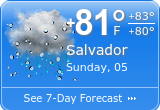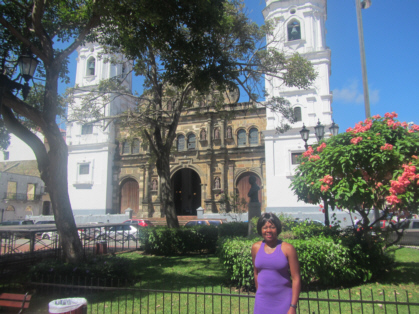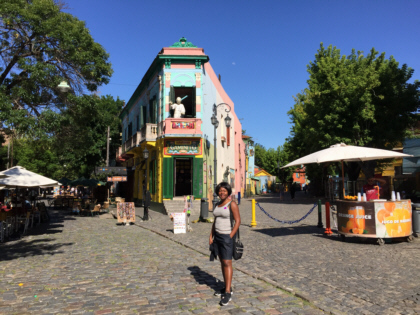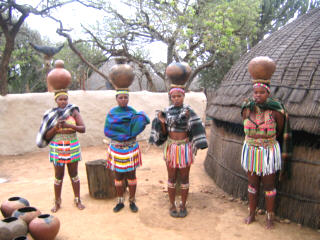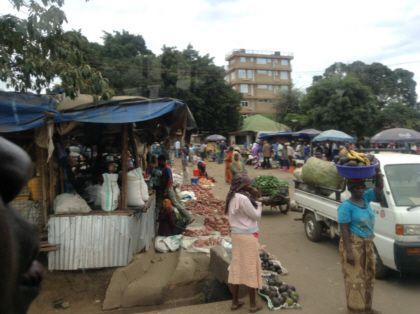Salvador Da Bahia
March 13, 2000 - March 16, 2000
Traci and I went on an Afro-Brazilian Cultural Tour with listeners and personalities from our local R&B radio station, WDAS FM. This was a combined trip with listeners from the Washington, DC station, WHUR FM, and listeners from WBLS FM in New York City. In all, there were around 180 of us. The trip itinerary called for three days in Rio de Janeiro, Brazil and four days in Salvador da Bahia. This trip report recounts the Salvador da Bahia leg of the trip.
Things I Really Enjoyed
- São Francisco Church: I wasn't prepared for the beautiful interior of this church. The walls and statues are lined with gold leaf. You have to see it to believe it. Photos don't do it justice.
- Visiting Ilê Aiyê: This group is involved in issues that affect Afro-Brazilians. Salvador has dealt with racism and discrimination for centuries. We met the president and founder of the organization, Antônio Carlos Vovô. Ilê Aiyê also consists of very talented musicians. I was able to buy one of their CDs and get some of the musicians' autographs.
- Visiting a Candomblé community: Candomblé is an African religion that is widely practiced in Bahia. We were allowed to enter some of the temples and learn about the religion.
- Tuesday Night in Pelourinho: Tuesday night is the party night in Bahia. We hung out in the Pelourinho section of the city, listened to live music, wandered the cobblestone streets, checked out shops, and people watched.
- Folklore Show: The highlight of this show was the Capoeira (martial arts combined with dance). These guys were flexible and quick. The sparring was done to the rhythm of the drum and a berimbau (bow-like instrument). This was an amazing display of skill and courage.
- The Countryside: On our way to the town of Cachoeira, we stopped at a farm community where we were invited into the house of one of the farm workers and visited an elementary school on the property. This was a nice contrast to the city life of Bahia.
- Sisterhood of the Boa Morte: In the city of Cachoeira, we visited the Sisterhood of the Boa Morte, the oldest black sorority in the western hemisphere. The origin of this group goes back over 200 years, at which time the organization was involved in helping newly freed slaves get on their feet. We met some of the senior members of the organization and learned about some of the community and educational work the sorority is involved in today.
- Our tour guide: Paula Santos was the tour guide for my bus assignment. She was amazing. She was like a walking encyclopedia and still lively enough to keep our attention on every tour. Unfortunately, I don't remember the name of the tour company she works for.
Things That Disappointed Me
- The poverty: We saw favelas (slums) just about anytime we saw hills. We also encountered a few street children who had to beg for money. These conditions are an unfortunate result of the high unemployment rate in Brazil and the large division between the rich and poor. It made me sad to see such poverty.
Trip Report
Salvador da Bahia
After three days in Rio de Janeiro, Salvador da Bahia was the next stop on our Brazil trip. Our tour group was divided among three flights: 8 a.m. flight; 10 a.m. flight; or 4 p.m. flight. Traci and I were on the 10 a.m. flight. Salvador da Bahia (or Bahia as it is commonly known) is about two hours north of Rio by plane. Our flight was uneventful until the final runway approach. It was a clear, sunny day; however, I don't know if it was turbulence, an inexperienced pilot, or both, but our plane began to wobble. The pilot finally gained enough control to put the plane down with a loud bang. That was the hardest landing I've ever experienced.
Now that we were on the ground safely, we exited the plane and then boarded a shuttle bus that took us to baggage claim. The first thing I noticed when stepping off the plane was the heat and humidity. It felt like South Florida in July.
We collected our bags and made our way to the 4-star hotel tour bus. I did not know much about Bahia other than it is known as the heart and soul of Brazil because of its strong African culture. Our disappointing hotel and tour guide experiences in Rio were still fresh in the minds of Traci and me. We really had little hope that things were going to get much better; however, we resolved to keep an open mind and to do our best to enjoy the rest of our vacation.
After a short while, a tour guide stepped on the bus and said with a big smile, "Welcome to my city, Salvador da Bahia, the most beautiful city in the world!"
You could almost hear the sighs of relief of all of us on the bus. I think all of us were thinking the same thing - "He speaks English - fluently". He said he heard we had a rough time in Rio but he said we would enjoy his city. As the bus began to pull off, our tour guide went to work. He began to point out landmarks and tell us about the city. Salvador used to be a big slave trade city. What makes the city unique is that the Africans who were brought to Salvador have held on to much of there African culture. This is evident in the music, religion, and food. It is for this reason that Salvador da Bahia is known as the Heart and Soul Of Brazil.
Bahia is not a place that I hear much about. It was difficult for me to find much information about it on the Internet while I was preparing for the trip. Our tour guide told us about a movie that was filmed there, "Moon Over Parador". I saw the movie when I returned to the States. It was a funny movie. I recognized Bahian landmarks in many of the scenes.
We also learned a little about the musical group, Olodum. Olodum uses lots of drums and percussion in their songs. Michael Jackson used the group for his track, "They Don't Care About Us". Olodum also appears in MJ's video which was filmed in Bahia.
I was fascinated by the sites I saw as we rode through the city on the way to our hotel, Tropical da Bahia. Things were so different then what I was used to seeing. Many of the houses had red, clay roofs. We rode by a lake that contain statues of Orixás (deities of the Afro-Brazilian religions). These were not just monochromatic statues, they were painted in bright colors.
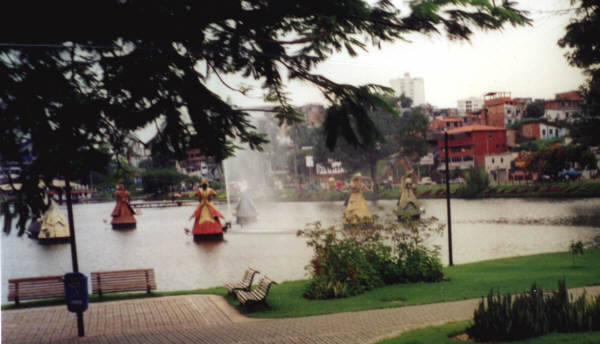
Orixás statues
I noticed the store fronts did not have doors and windows. They were just wide open - almost like a large garage. The shopkeepers would just lower a large metal door when they closed up for the day.
Unfortunately, there were some sites that weren't so pleasant to look at. These were the favelas (slums or impoverished neighborhoods). One thing I noticed while we were in Rio and Bahia is that if you saw hills, chances are the hills contained favelas. These favelas appear to have been built by stacking wooden or clay houses on top of one another. They looked like they would topple down the hill at any moment. Something that intrigued me about these favelas, is that although they looked very run down and poor (we were told many of them do not even have running water), it wasn't uncommon for me to see houses with satellite dishes.
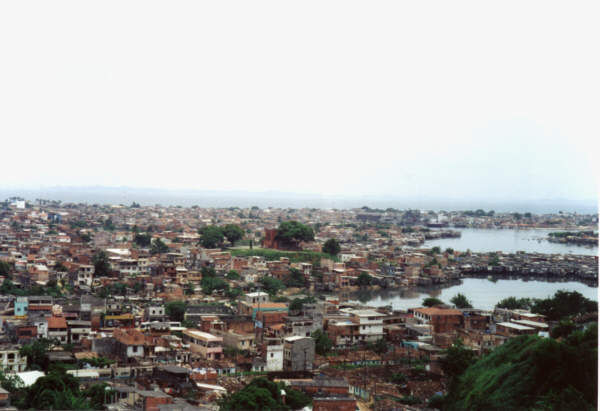
a favela (slum)
Tropical da Bahia Hotel
Eventually, we arrived at our hotel, Tropical da Bahia. Before we got off the bus we were given information about tours, check-in, hotel amenities, and surrounding areas. There was a special table set up for our group in the lobby of the hotel so that we could walk in, sign the registration sheet, and pick up our room key. This process only took 15 minutes - unlike the two hours of chaos we experienced during check-in at our hotel in Rio. Things were starting to look good, but would we have a better room than the one we had in Rio? We hurried to the elevator and went to check out our room. Excellent! We had a big, modern room that was spotless. It had a nice, clean smell - no ocean or mildew smell like in Rio. There were still no wash clothes but that was no big deal at this point.
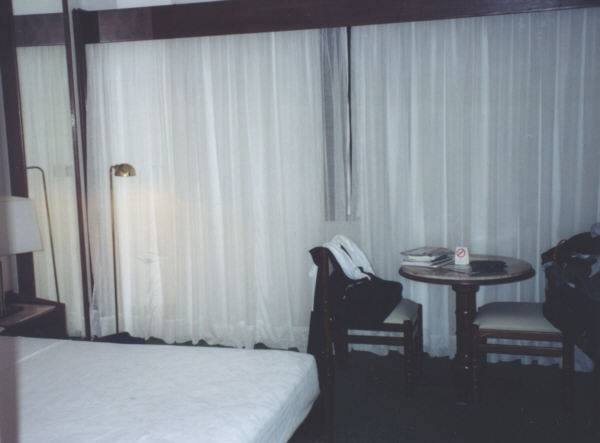
our room
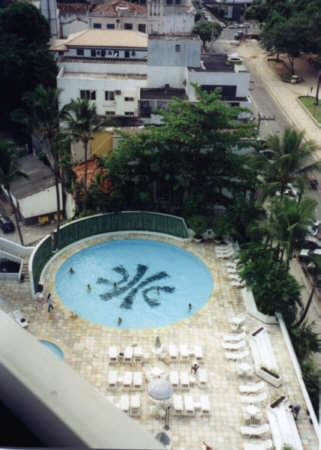
view from our room
Historical City Tour
Traci and I changed our clothes to accommodate the hot, humid weather and headed to the lobby for our tour of the city. Salvador da Bahia is divided into two parts: Upper city and Lower city. The Lacerdo Elevator joins the two parts for pedestrians. Vehicles have to navigate the roads to get from one part of the city to the other. On this tour, we met, Paula, who would be our tour guide during the rest of our stay in Salvador da Bahia. Paula was an outstanding tour guide. She was very knowledgeable, organized, personable, and even opinionated at times.
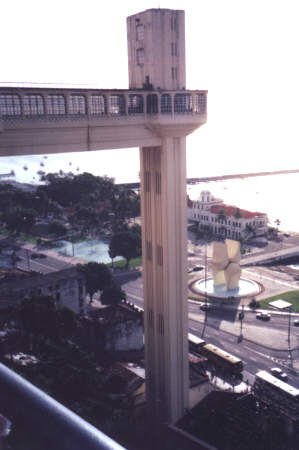
Lacerda Elevator
The Historical City Tour was a tour of the Upper City which consisted of a short bus ride to an area often referred to as the Old City. Once we arrived in the Old City, we did the rest of the tour on foot. It has been said that Salvador da Bahia has 365 churches - one for each day of the year. One of the churches we entered was São Francisco Church which was built in the 1500s by slave labor. This church totally blew my mind. I have never seen anything like it. The walls, ceilings, and statues were lined with gold leaves. There was so much gold in the church it seemed like it could blind you. We weren't allowed to take pictures of the interior (but Traci managed to get off a few shots before we were told not to). Frankly, I don't think a photograph would have does it justice. The slaves were forced by their masters to build this magnificant church, yet they were not allowed to practice their own religion. In a sort of rebellion, the slaves disfigured some of the angels sculpted and painted in the church by displaying them with large genitals. There are even some angels that appear to be pregnant. Paula pointed out to us that although the slaves built the church, they were only allowed to worship (catholicism - not their own religion) in a small room at the back of the church. This room had plain white walls with no gold. A person could not even see the altar from this slave room.
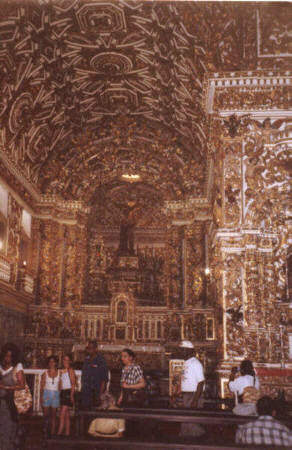
São Francisco Church
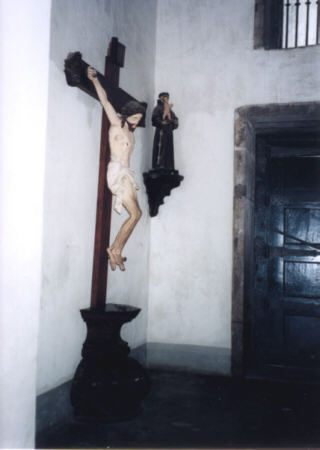
slave room of the church
Paula told us that this type of discrimination still resonates in Bahia today in a less blatant form. Salvador da Bahia is 80% black; however, most of the businesses are owned by non-blacks. We did notice this during our stay in the city. Not only does racism exist but there is even discrimination amongst the blacks in the city. There is a desire to be light-skinned as opposed to being dark-skinned because you are considered more attractive. Fortunately, these view are starting to fade. Bahia is in a Black is Beautiful movement where people are starting to take pride in who they are and where they've come from. Continue...
UNESCO Site Visited At This Destination:
